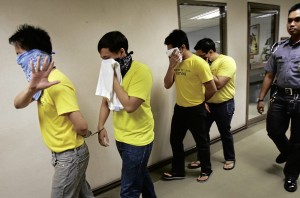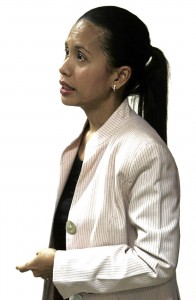Guard recounts US Marine Anikow’s slay
MANILA, Philippines—The security guard who witnessed the fatal assault on US Marine Maj. George Anikow in Makati City testified in court on Thursday, recounting the predawn “rumble” between the American and four Filipino men.
Jose Romel Saavedra, however, admitted that he did not see who exactly among the four suspects stabbed Anikow, the husband of an American diplomat then posted in Manila, at a checkpoint in Bel-Air subdivision near Rockwell Center on Nov. 24 last year.
Requiring a translator, the Southbend Security employee spent about four hours on the stand at the sala of Judge Winlove Dumayas of Makati Regional Trial Court–Branch 59, as the main prosecution witness in the murder case being monitored closely by the US Embassy.
He said a cheerful and drunk Anikow approached him coming from P. Burgos Street around 3:50 a.m. on Nov. 24, asking for the time Gate 4 on Rockwell Drive will open.
With Anikow still around, Saavedra then stopped an approaching Volvo SUV and asked the driver—suspect Juan Alfonso Abastillas—where he and his three companions in the vehicle were going.
Article continues after this advertisementIt was at this point, he said, that Anikow butted in and, with a firm voice, told the suspects: “Present your ID. The guard is checking you. Respect the guard, respect the guard.” Abastillas then turned to Saavedra and asked: “Sino ba ’yan (Who’s he?)”
Article continues after this advertisementSaavedra said he asked Abastillas to excuse Anikow’s behavior for he was drunk, and that he tried to create space between the two men by slightly pushing the American back.
As he removed the road cones to let the vehicle pass, Saavedra recalled, he heard a loud tap on the vehicle. Asked to describe how loud it was, he pounded the judge’s table.
An exchange of foul words then ensued between Anikow and the Filipinos, he said. Abastillas then moved the Volvo around five meters away from the checkpoint and the four Filipinos got off the vehicle.
Saavedra said Anikow then punched one of the accused, knocking him to the ground. Saavedra said he tried to intervene but the fist-fight had begun. He also thought of protecting the shotgun he was carrying since one of the brawlers might grab it.
Anikow then ran toward P. Burgos but two of the suspects chased him, quickly followed by the other two. Saavedra said he still did not know that Anikow was stabbed at that point.
Returning to their vehicle, the suspects then told the guard: “Gago ’yan (he’s crazy),” referring to the victim, and drove off toward Estrella Street. Saavedra then radioed for help as
Anikow lay bloodied on the pavement.
An ambulance came for the American 30 to 40 minutes later, he said, adding that Anikow was still breathing when he last checked him before he was taken to the hospital.
In an interview after the hearing, defense lawyer Jay de Castro said, “What’s good here was that we were able to show through Saavedra’s testimony that sufficient provocation and unlawful aggression started from Anikow.”
The lawyer also noted that “Mr. Anikow (who was described by Saavedra to be about six feet tall) was much heavier, bigger, taller than each of the accused, such that abuse of superior strength (a factor in proving murder) could not apply.”
But Hannah Arriola, the lone public prosecutor in the case, said: “They can say George Anikow was the one who started (the fight) or that it was the guard who was at fault because he did not stop Anikow or failed to use the necessary force to stop him. They can say it was the fault of the ambulance for not arriving on time.”
“But at the end of the day, if they (the accused) did not stab him, if they did not gang up on him, there will be no need for an ambulance,” she said.

